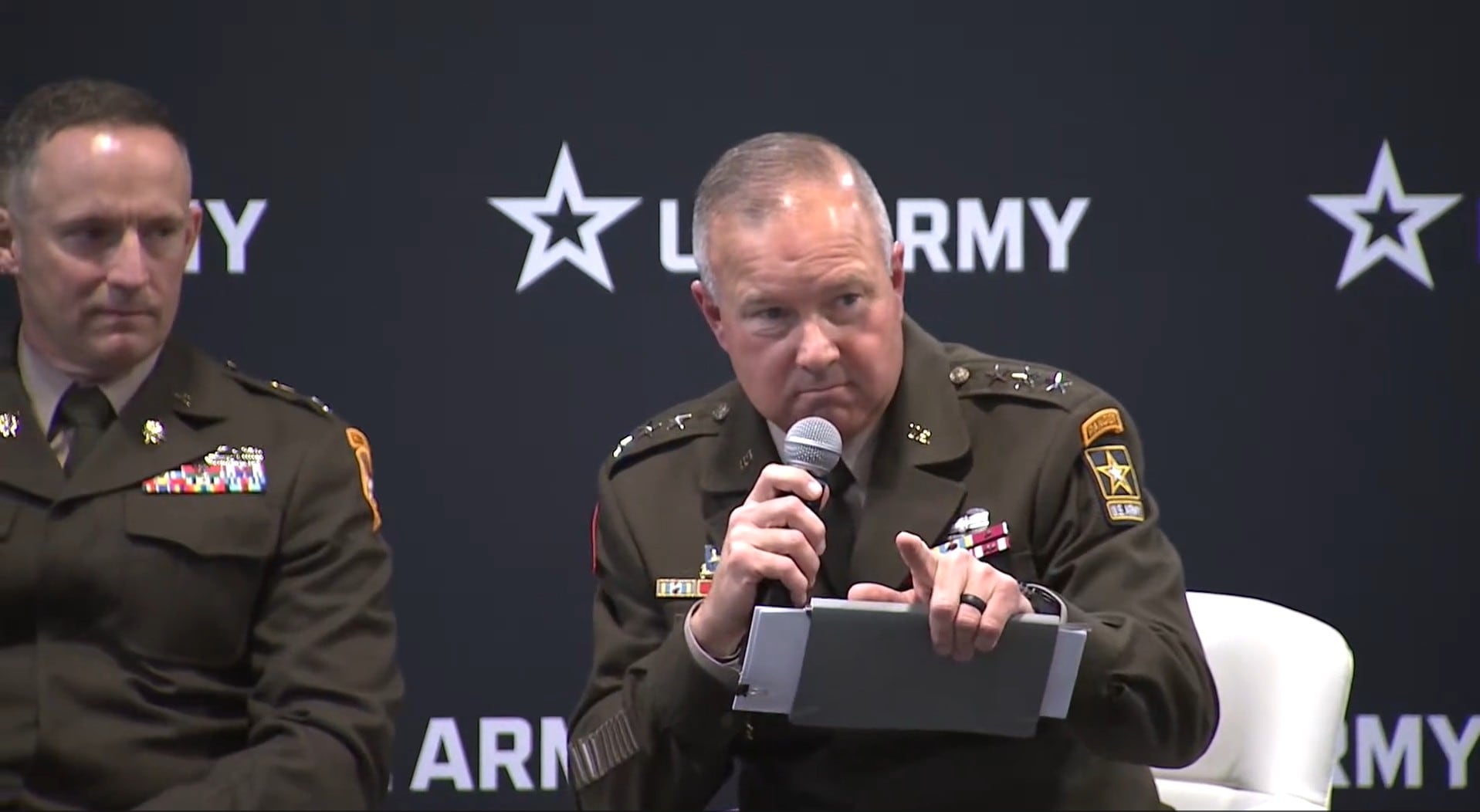This article first appeared on March 13 at 4:56 p.m. and has been updated.
ABOARD THE CRUISER NORMANDY, ATLANTIC – The whiteboard in the chief’s mess aboard this ship guided-missile cruiser Normandy had a lot of notes on it the morning of Dec. 12, 2015.
But The two that stuck out: "One Epic Cruise" and "Best Crew Ever."
The mess was full of activity. The ship was returning that day from its 279-day deployment and after steaming approximately 70,000 miles around the globe were only a few miles from home. as was the passage way outside. The whole ship was abuzz with activity and excitement because after a 279-day and 70,000 nautical mile circumnavigation of the globe — they were just a few short miles from home.
"This ship covered a lot of ground during the past nine months and I couldn't be prouder of these sailors and what they accomplished," said Capt. Scott Robertson, the ship's commanding officer. "Along the way, we had the opportunity to go places and do things that East Coast ships don't normally get to to."
By any measure, the cruise was epic. They proved the value of the fleet's latest air-defense system and participated in months of strikes against ISIS. They made 11 port calls and saw places like Singapore and Leyte Gulf that Atlantic fleet ships rarely get to see. They escorted an aircraft carrier to its new homeport and in the process earned their right to boast of one of the fleet's longest deployments, and perhaps one of the last as fleet bosses work to keep cruises under seven-and-a-half months. And the ship returto deploy longestThe Aegis cruiser tied up in Norfolk on Dec. 12, just three days after the ship’s celebrated 26 years of service in the fleet. Until this most recent trip, the ship had never sailed across the Pacific Ocean — nor had it pulled into Pearl Harbor, Hawaii, and rendered honors to the Arizona memorial.
Normandy crewmembers can now check those off the bucket list. Those experiences and more are now checked off the ship’s bucket list, as well as the lists of many of her crew.
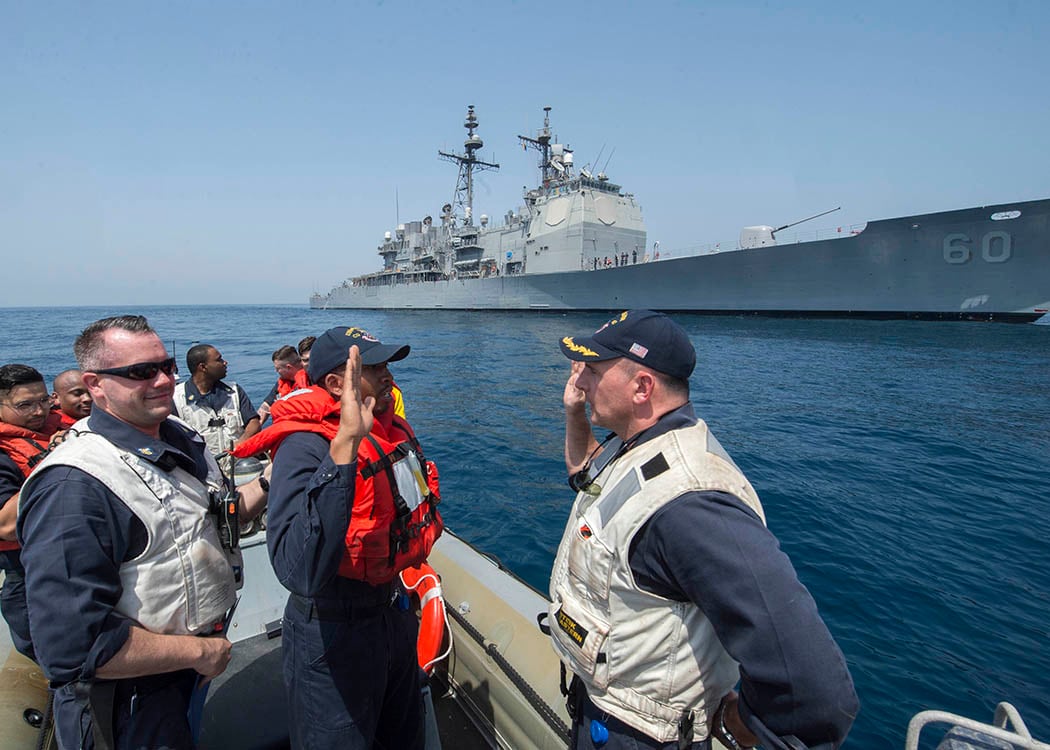
Capt. Scott Robertson, right, the CO of the cruiser Normandy, reenlists Boatswain's Mate 3rd Class Edward Holmes in a small boat in 5th Fleet, where the cruiser was supporting missions against the Islamic State militancy.
Photo Credit: MC3 Justin R. DiNIro/Navy
The ship departed Norfolk and headed east on March 9 along with the Norfolk-based guided-missile destroyers Forrest Sherman and USS Winston S. Churchill, as well as the Mayport, Florida, guided missile destroyer Farragut (DDG-99).
Their job: escort the aircraft carrier Theodore Roosevelt to the Persian Gulf, which departed Norfolk on March 11 and spent .
Normandy deployed with carrier Theodore Roosevelt and destroyers Forrest Sherman, Winston Churchill and Farragut. But only Normandy "pulled a Magellan" as some in the ship's crew call it — making a complete circumnavigation of the globe.
"I've commented numerous times to the crew that they will tell their children and grand children about this cruise — the time you sailed around the entire globe on one deployment," Robertson said the night before arriving back in Norfolk. "It's something you're going to share with your kids for the rest of your lives."
The last night at sea was a time of reflection for Robertson and most of the crew. Not only were they in the last miles and hours of the nine-month 279-day deployment, they’d actually spent 313 days underway — 52 days shy of the entire year — underway.
"I have absolute confidence, that even through all the pain of the separation from our families, there is going to be a tremendous sense of accomplishment these sailors will have when they walk off that brow tomorrow," Robertson said. "The team feels very good about what we did and what we accomplished and you can put your chest out a bit when you walk down the pier with a Normandy ball cap on."
A look at their "epic" cruise:
'A lot riding on this'
Now, The Normandy has one of the most seasoned crews operating what's regarded as the fleet's most fearsome surface combatant. But that's a far cry from where the crew was a year and a half before.who who operate arguably the newest and most lethal weapons platform any Navy has ever seen. But that’s now and a far cry from from the freshly overhauled ship chock full of inexperienced sailors a year and a half before.
"When the the CO took command in May 2014, he asked me what my areas of concern were," said Command Master Chief (SW) Gregory S. Carlson, the ship’s senior enlisted sailor. "I told him my greatest concern was the experience level of the crew because only about one quarter had ever deployed before."
When Robertson took over, the ship had recently completed an extended overhaul [XXXAwaiting dates from the ship/mf] long yard period at Norfolk’s BAE Systems shipyard. They’d been upgraded with the latest and greatest Aegis systemversion of the Aegis system — Baseline 9, as it’s called and once the’d trained up, they would be the first to deploy with it.
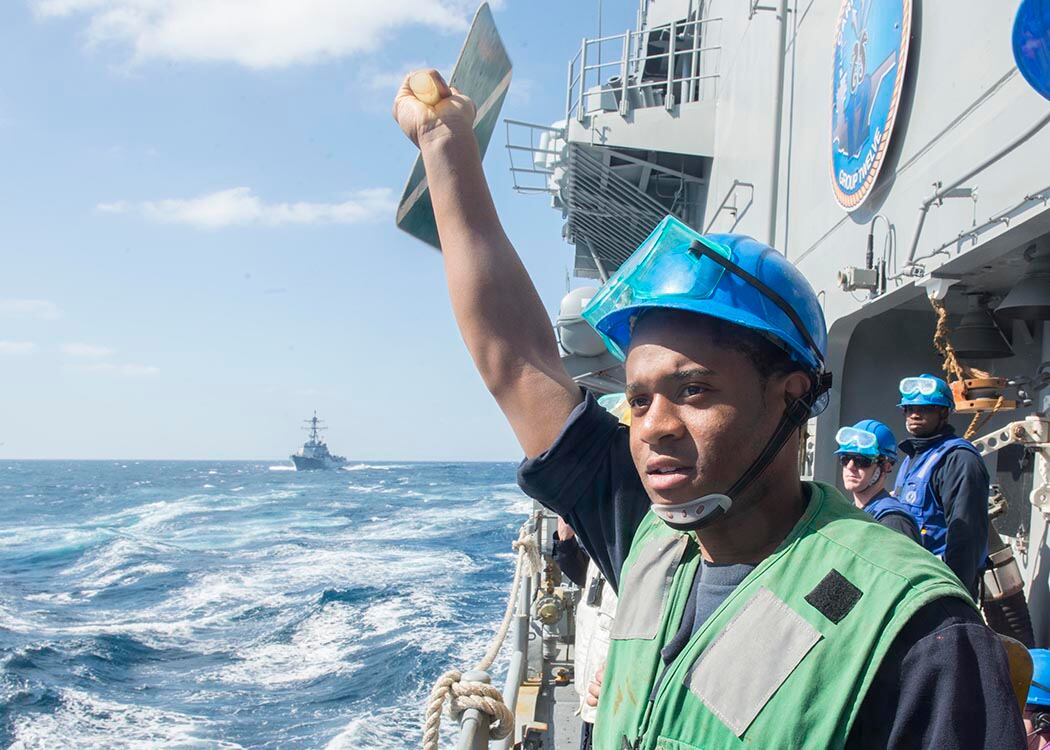
For most of the crew, Normandy's round-the-world cruise would be their first deployment. Here, Seaman Devin Williams-Justice signals to a replenishment ship at the start of the deployment.
Photo Credit: MC3 Justin R. DiNIro/Navy
Carlson credited the ship's previous skipper for a well coordinated yard period, adding that the proof was how well systems worked "out of the box." said the foundation of the success was how well the yard period and how well everything worked nearly "out of the box" he said once it was done. That success, he said, was due to the diligence of the ship’s previous commanding officer Capt. Kevin Hill.
"He really knew this ship and practically could tell you about every valve on it," Carlson said. "I only work with him six months or so, but he kept the yard on track and ensured that everything worked when they were done."
Robertson, who had been slated to command cruiser had initially been due to take over San Jacinto, was re-routed to the state-of-the-art Normandy because of his particular expertise was sent instead to Normandy because of his particular skill set — air defense.
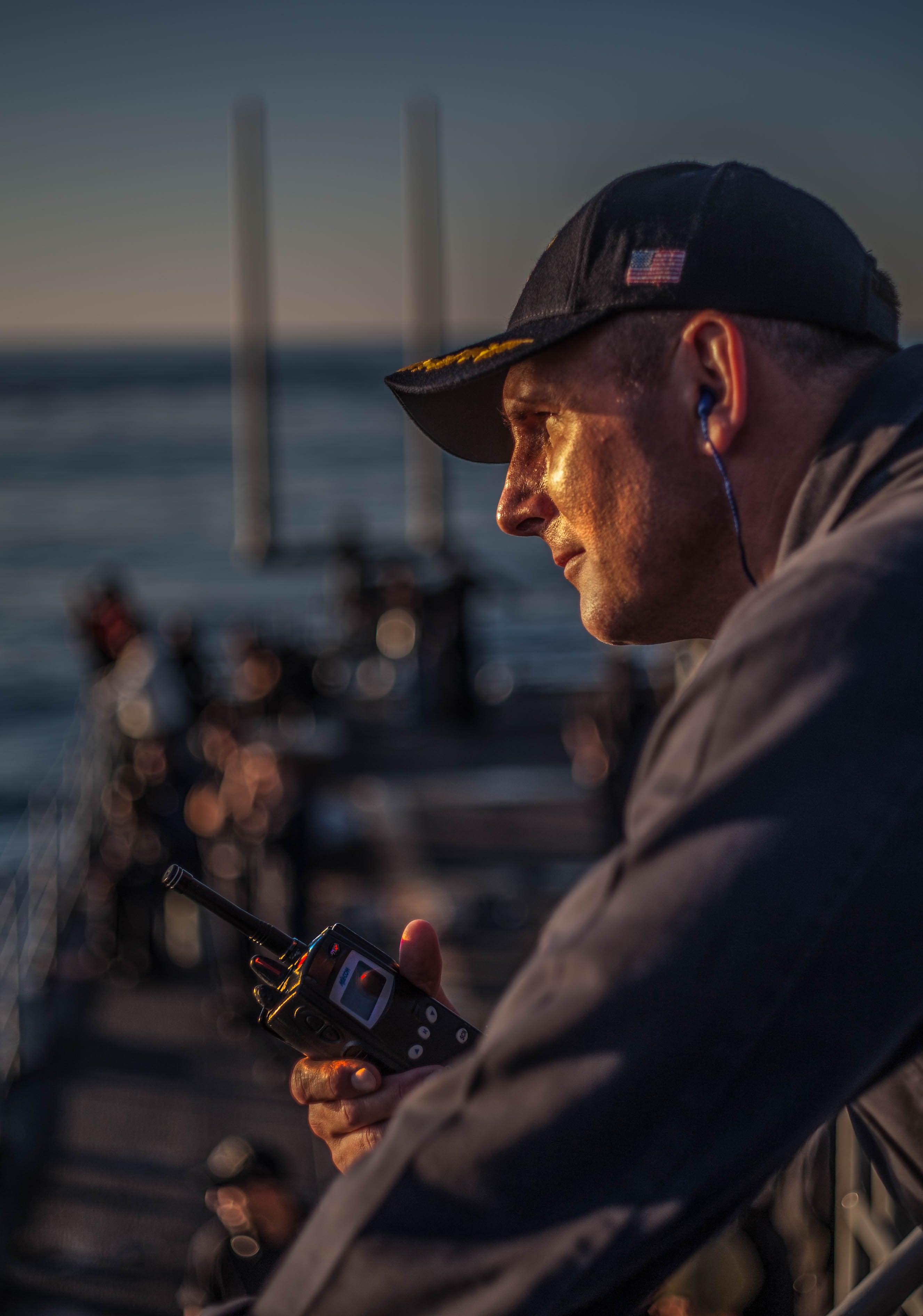
Capt. Scott Robertson has earned a reputation as a sailor's sailor. He joined the Navy in 1986 as a non-designated seaman and was selected for BOOST, earning a four-year ROTC scholarship. He also has a soft spot for coffee, giving up his personal galley on the ship to be a popular MWR latte shop for the crew.
Photo Credit: Mark D. Faram/Staff
"Baseline 9 represents the newest Aegis software and hardware capability and one of the key key components of that is NIFC-CA — Navy Integrated Fire Control, Counter Air," Robertson said. "It’s a large increase in capabilities in order to defend ourselves and strike groups from anti-ship cruise missiles."
Robertson was in the right place at the right time with the right skills.
"We were bringing the NIFC-CA capability for the first time to an operational status and deployed operations — we had to have someone who is comfortable and confident in those types of operations and I fortunately had that skill set.," Robertson recalled. "The Navy rushing to get baseline 9 to deployment. Because "There was a lot riding on this deployment, a lot of firsts."
The latest air defense system wasn't the only thing Normandy had going for it — the ship was also set for a nine-month world cruise on which to test it. Robertson found out once reporting to Normandy that not only would he have all these new toys to play with, he’d have nine months and a round the world cruise to play with them.
They would be writing the book along the way. Not only were they training up as a ship for deployment, as the first with this new system, they were in some ways, writing the book along the way.
"Because we were to be the first Baseline 9 ship to deploy, we had a lot of extra requirements that we had to do in system validation and then we had the rest of the things everyone else has to do on top of that — all crunched together.
"We were forming the tactics and how this would be deployed in the future all along in our basic phase of training and through the intermediate and advanced phases of training," he said.
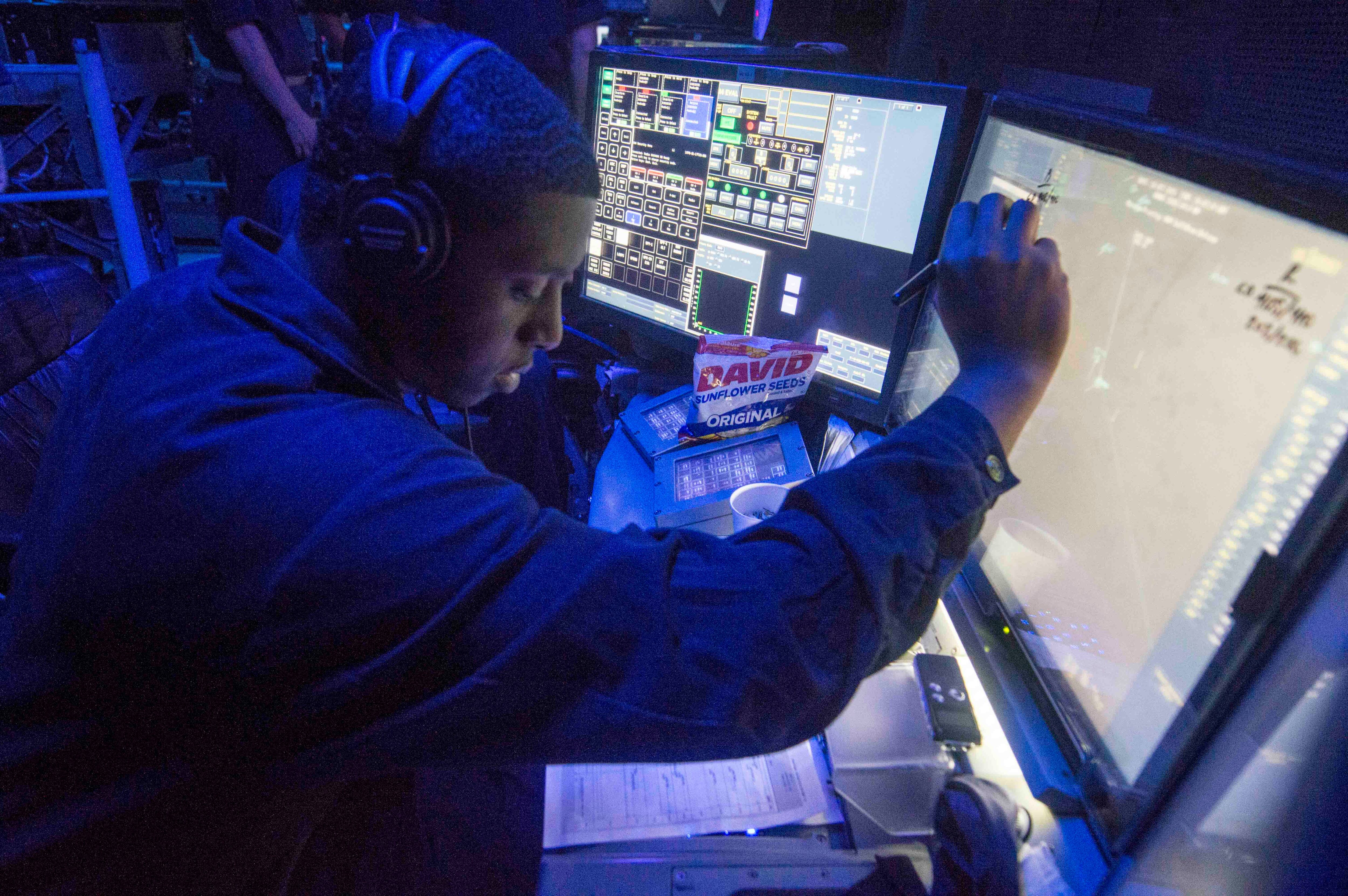
As the first crew to deploy with the fleet's latest air-defense system, Normandy wrote the book on how to operate it. Here, Operations Specialist 1st Class Keith Tatum participates in an air-defense exercise in October with allies from the Japanese and Indian navies.
Photo Credit: MC3 Justin R. DiNIro/Navy
'Feather in the cap'
With a deployment in March looming on the horizon, their training schedule was very aggressive and Carlson said the crew responded, gaining confidence in themselves and their newly overhauled ship as learned their new ship’s capabilities. The only problem: the surface Navy's most hated inspection was smack dab in the middle of work-ups.
But smack dab in the middle of this schedule, the ship was slated for one of the most hated inspections by ship's crews — INSURV.
With the inspection shoehorned between at sea periods, Robertson said it was during this inspection process that he knew his crew was special
"If you look at our schedule and how little time we had to prep for [the Board of Inspection and Survey], it was ridiculous there was so little time to prep," Robertson said.
But Robertson, his wardroom and chief’s mess formed a plan and executed it amid deployment preps. It was like double-duty. to prepare the ship for the inspection while still training for deployment.
The inspection was slated to begin on a Tuesday in November 2014. to begin on on a November Tuesday after a three-day weekend in November, 2014. [getting actual dates here] The Friday before, Robertson sat at the desk in his stateroom. Chiefs and department heads milled outside his door. and leading chief’s milled about awaiting the word.
Would he make the crew and leadership work the three-day weekend to continue INSURV preps for INSURV?
"I came to the realization — no. We're ready," he said. "You guys did it. So we took the three-day weekend off and came in on Tuesday and executed a great INSURV."
It was a moment that he and members of his crew remember as a watershed for trust. Sure, the inspection wasn't perfect but they passed and that's what counted. became the watershed in trust both up and down the chain of command that cemented this rookie crew together and set it’s fate.
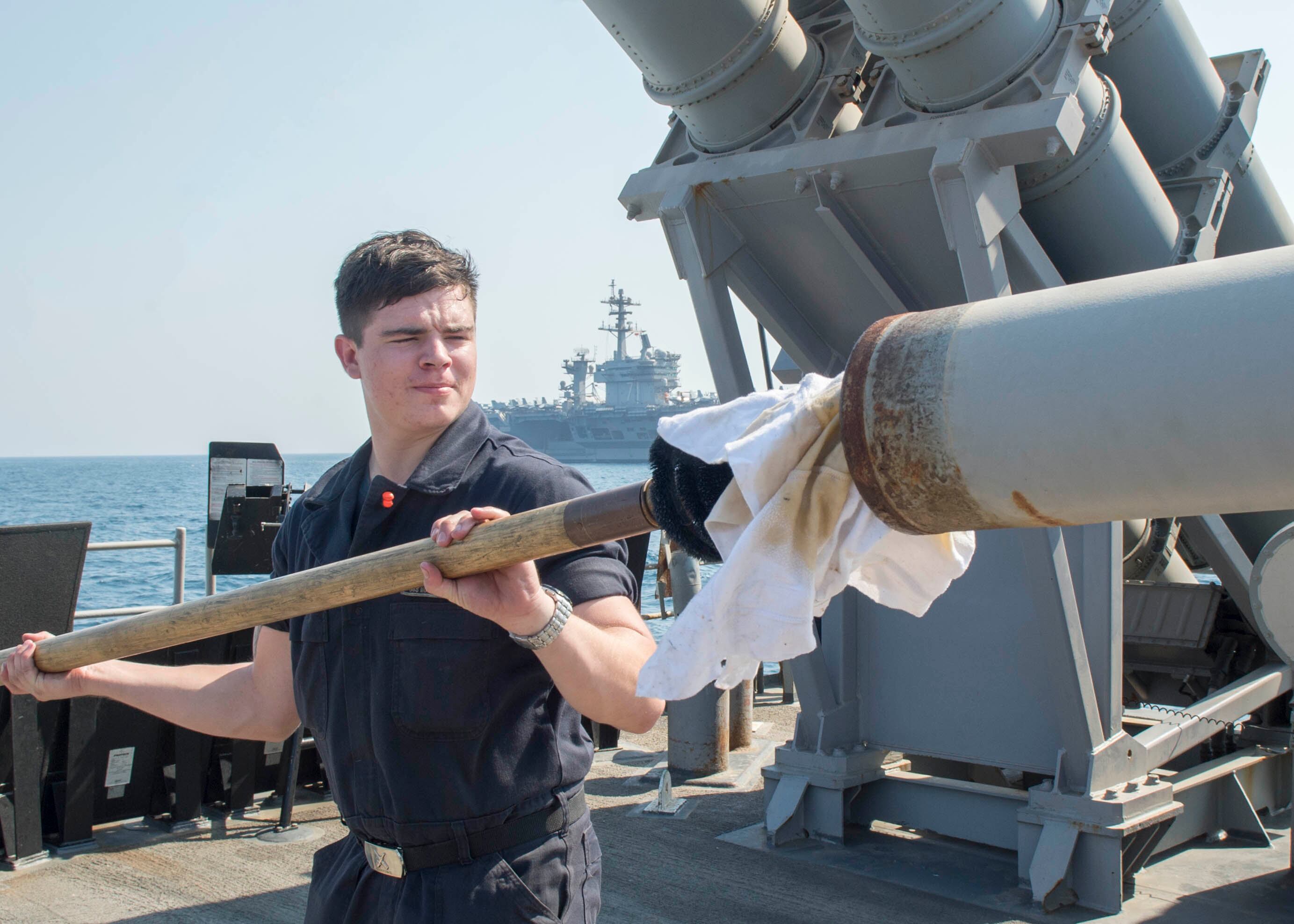
The crew said their skipper trusted them to do their jobs. Here, Gunner's Mate Seaman Sean Feia cleans the barrel of a one of the ship's 5-inch deck guns in September.
Photo Credit: MC3 Justin R. DiNIro/Navy
Carlson would say the inspection wasn't perfect, but it was good enough to pass muster and that's what counted.
"You can always be better than you need to be, but the fact was that we passed the inspection and went back on our way in training for deployment," Carlson said.
Many said Robertson's vote of confidence before INSURV forged strong bonds. Football analogies fly around the Normandy crew when they discuss their command’s leadership and the incredible bond this crew developed while preparing for and making the round the world deployment.
But most who were around doing workups say this moment and the CO's trust in the crew made
"It’s trust and this crew feels it and reacts to it. It starts with the leadership — and we’ve been blessed with the best with this captain, CMC[command master chief] and XO — they simply trust us to do our jobs," said Gunner’s Mate 2nd Class Richard Bumgarner, who has now spent nearly half of his two years in the Navy underway on Normandy.
"When there's problems with gear, the CO doesn't like any filters, he asks the tech responsible what's wrong and asks you how to fix it.The crew matters to them — at least it seems that way to us."
It was uphill to learn the new air-defense system but the crew continued to gel. Their composite training unit exercise was different that what they'd done in the past.
Robertson noted that it had a 7th Fleet feel — "which is what our capability was designed to counter," he added. "We did real well." From there, it just got better. Normandy’s crew continued to gel as a team and from the lowest to the highest the crew was developing a personal ownership of the ship’s mission and fate.
"We really had a steady glide slope up as well, learning how to use this new combat system — so we did really through our group sail, but we really shined when we got back to our COMP2EX," Robertson said.
This was different than than ay other COMP2EX that had been done in the past, because we were the first ones with NIFC-CA and they generated a seventh-fleet feel to it, which is what our capability was designed to counter — we did real well."
At the end of the exercise, the officials conducting it said that Normandy was the most lethal cruiser they'd ever seen. the Robertson said that those conducting the exercise told him at the end that Normandy was the most lethal cruiser they’d ever worked with.
"So that was another real feather in the cap for this crew," he said.
"When you start piecing together all these 'wins' it developed a self sustaining level of motivation and realization among ourselves that we really did have a good team and that continued to propel itself into the cruise."
'This is serious'
Quartermaster Seaman Darius Ringer arrived in Norfolk on March 6, holding orders for the Normandy. He was settling into his barracks room when he got a call from the ship. entered his Navy basic training Sept. 23, 2014. It was about the time Normandy’s crew finished their basic phase of workups.
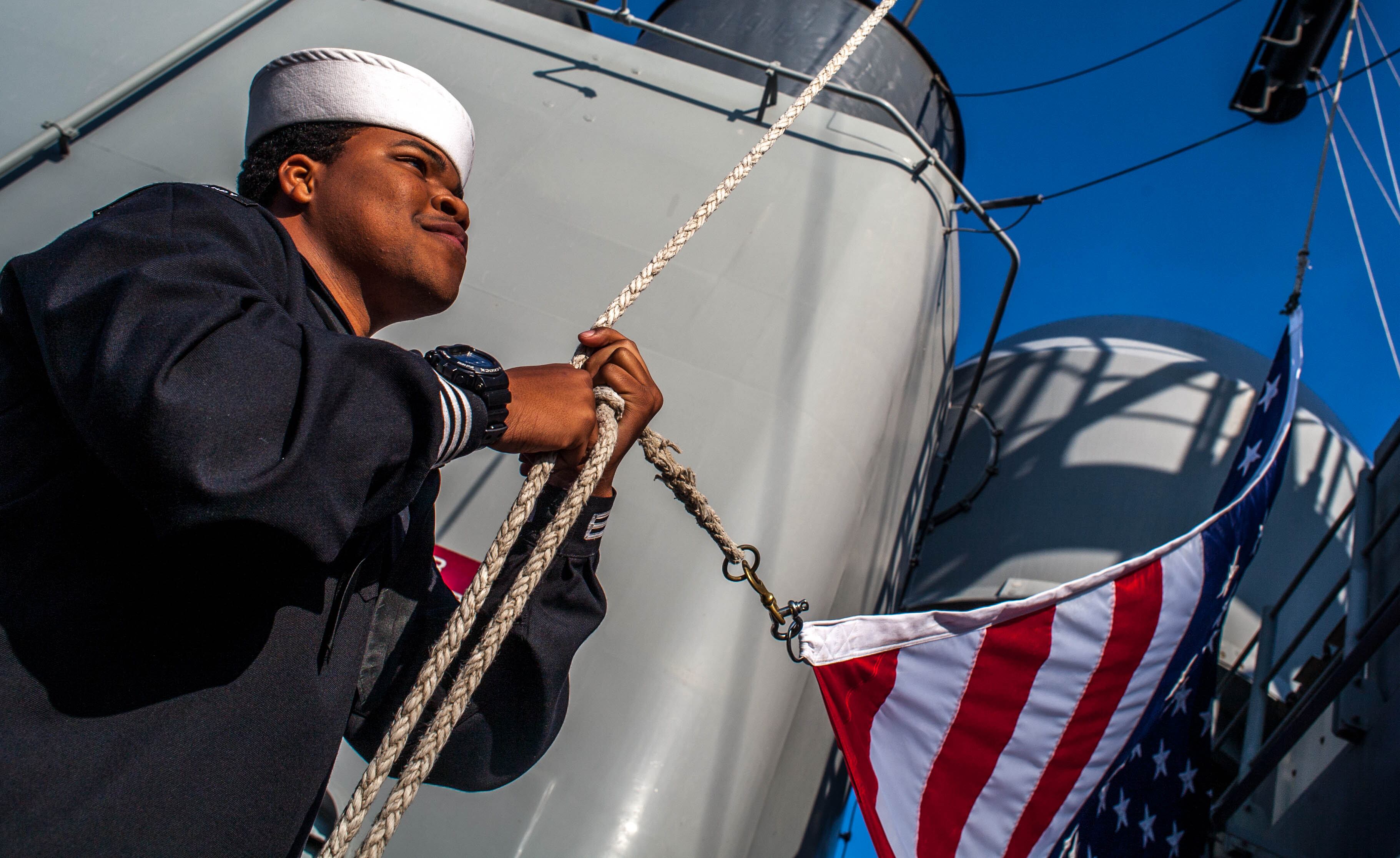
Quartermaster Seaman (SW) Darius Ringer was the last sailor to report to Normandy before it left Norfolk. He officially marked the symbolic end to the ship's world cruise by hauling down the underway colors from the yardarm.
Photo Credit: Mark D. Faram/Staff
Though Ringer didn't know it, he was on a crash course for destiny that would kick his Navy career into high gear right out of the gate.
Rucker, with orders in hand for Normandy arrived in Norfolk, Friday March 6 and was settling into his barracks room when he got a call from the ship, he said.
"'We've been looking for you,' they told me and they were looking forward to me getting on board," they said. "And, 'Oh by the way: We're leaving Monday for a nine-month, around the world cruise.'"
Ringer hung up the phone and reality sunk in. the reality hit him, he said.
"At first I was really excited and then I got really scared," he recalled. He wasould be the last sailor to report to Normandy before they left.
His head was still spinning as the ship pulled away out to sea that Monday, March 9, and headed east. from the pier on Monday, March 9, heading east.
"As the ship was backing out, I'm standing there, manning the rails and I see families crying and saying goodbye and I said to myself, 'This is serious, this is a big deal, we're going on cruise,'" he said.
But just A few hundred feet away, Robertson was also thinking. He knew he was leaving port with a rookie crew — and that the regular season was about to begin. and though excited to take his ship to the real world, he knew he was leaving port with a rookie crew that just had an incredible training camp and the regular season was about to begin.
"When you think of the duration and how many miles that we were going to travel and through some extremely congested waterways on a 26-year-old ship — certainly there were concerns as there were potentially a lot of things that could go wrong on this deployment," he said.
"But a the same time, I'd have to say I had a lot of confidence when we were going through Thimble Shoals channel. I'd gained a lot of confidence in this crew and the ship through our workup phase. We were ready."
Carlson said he and the skipper told the crew this was a historic cruise, worked the crew and talked to them every chance they could about the opportunity this cruise was for them and that it was historic and unlike nothing they’d experienced before — even if they’d been in the Navy a while.
"Before we deployed, I spoke at a ship’s gathering and told the crew that this was our time, reinforcing that each and every one of signed up for this and it’s now our time to embark on an amazing deployment to go off and do our nation’s business," Robertson said. "I revisited this during regular intervals during deployment — that we were doing the nations’s work, and doing a great job at it."
The leaders wanted to build on the successes from work-ups as they headed east. But as the ship headed east, what both Robertson and Carlson were looking for was to keep the momentum of the successful workups and inspections going as they started the cruise.
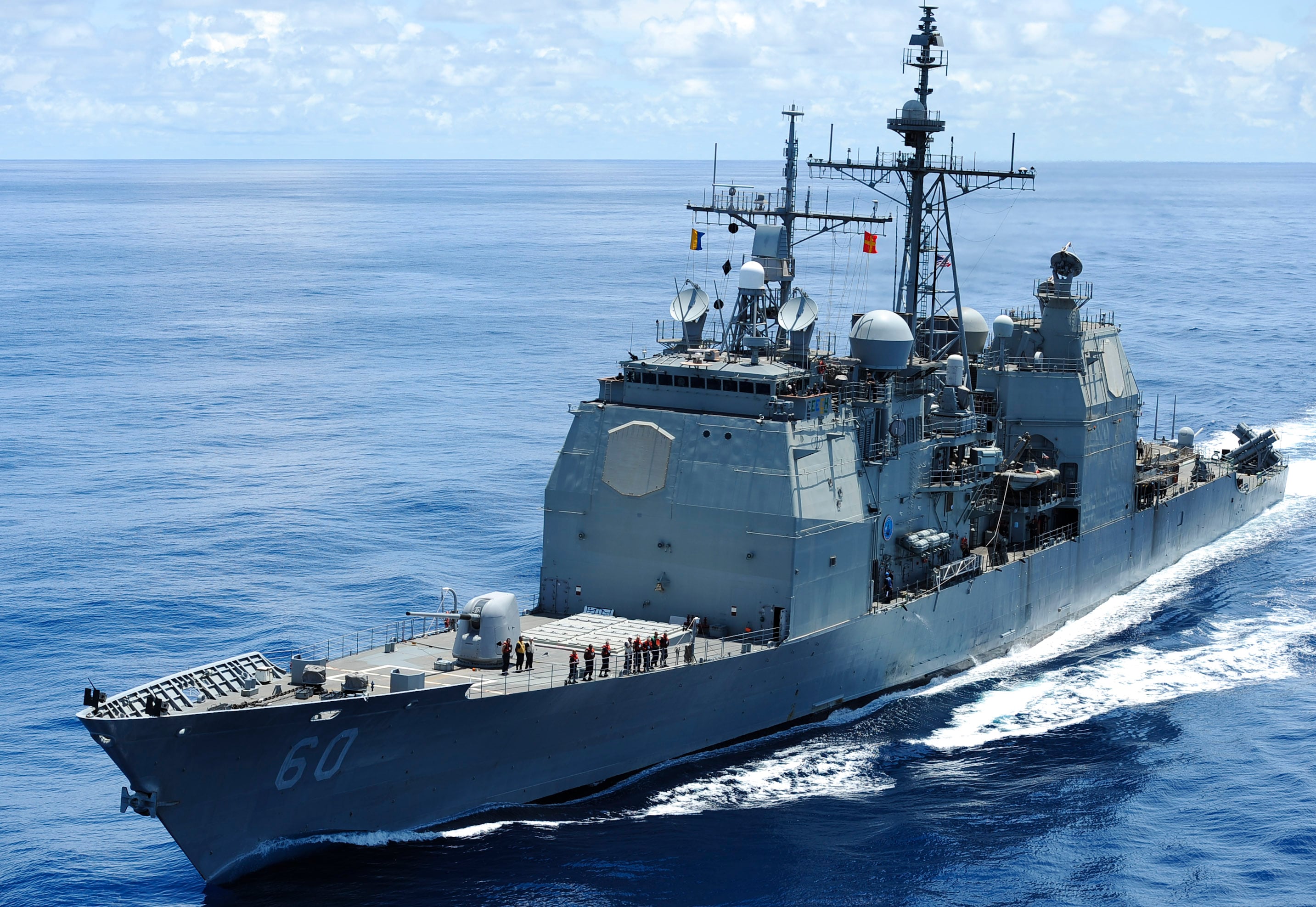
The cruiser Normandy sailed through the Mediterranean Sea to the Indian and Pacific Oceans, visiting ports that most East Coast-based crews seldom see.
Photo Credit: Anna Van Nuys/Navy
"It's important to get an early win because it helps set the tone for the crew and the deployment," Carlson said. "We were very fortunate that we found one."
On March 21, after just 12 days underway, the ship was conducting routine flight operations while transiting the Straits of Gibraltar, when the helicopter aircrew spotted a small boatcraft acting suspiciously.
Following the craft, They saw the boat’s crew dumping large packages into the Mediterranean Sea. The ship launched its small boats and recovereding 17 packages from the water. They were identified as illegal drugs and were destroyed. which were tested. and confirmed to be illegal narcotics and were destroyed.
"This was a big early win for us and helped us continue the momentum we’d left with," Carlson said. "The crew really saw what they could do to make a difference in the world — that they all could have an impact," Carlson said.
Coming soon: Normandy's crew sails to 5th Fleet to support strikes against ISIS militants and passes through the heart of the Pacific, in Part II.
Mark D. Faram is a former reporter for Navy Times. He was a senior writer covering personnel, cultural and historical issues. A nine-year active duty Navy veteran, Faram served from 1978 to 1987 as a Navy Diver and photographer.




